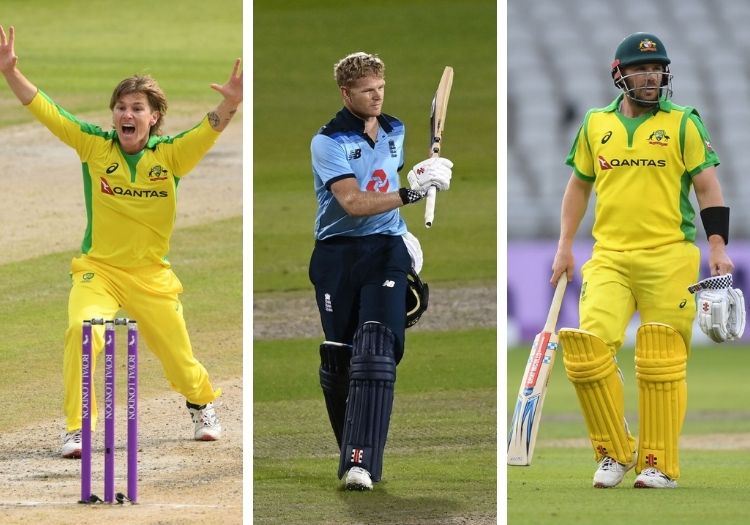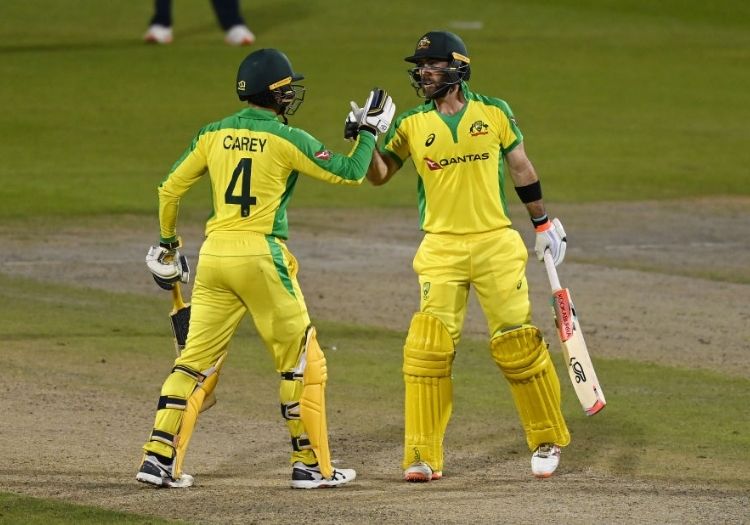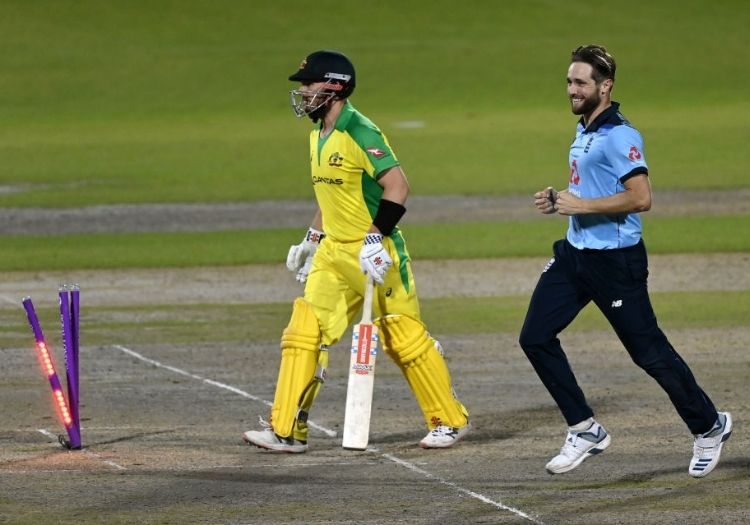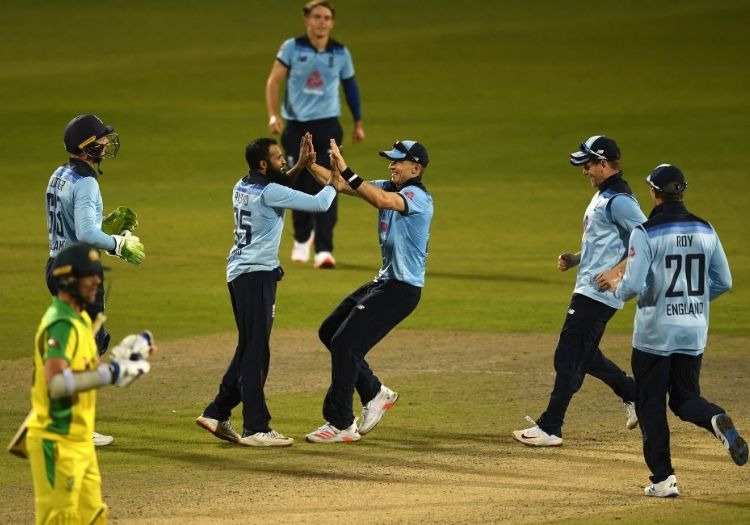The Cricketer looks back at the performances of all the players involved in the three-match 50-over series, which was won by a remarkable partnership between Alex Carey and Glenn Maxwell on Wednesday evening


Jason Roy (3 matches, 24 runs, batting average 8)
Jason Roy has had better summers. In nine innings in all cricket – for England, England Lions and Surrey, he has managed just 71 runs in nine innings with a high score of 24.
He looked to have hit himself into some rhythm in the second ODI against Australia before being run out. But in the final game, he sliced the first ball of the match to backward point to sum up a taxing campaign, which was disrupted by a side strain.
D
Jonny Bairstow (3 matches, 196 runs, batting average 65.3)
Not at his fluent best at any point but dug in manfully during the first ODI to drag England far closer to an unlikely win than they otherwise might have managed, before edging a good one from Mitchell Starc without scoring in the second match.
In the third game, he was tremendous: England were 0 for 2 after two balls and Bairstow had watched the carnage unfold. Gradually, he began to unleash, helping himself to a terrific tenth ODI hundred.
A-
Joe Root (3 matches, 40 runs, batting average 13.3, 2 wickets, bowling average 23)
Given a proper working over by Australia’s seamers, who were utterly relentless in pursuit of the wicket of England’s Test captain. He was given so little to hit throughout the series that at one stage in the second ODI, he had faced 28 balls for just three runs.
He turned that into a hard fought 39 that was worth far more by the end of the game that it seemed at the time. In the decider, he was trapped palpably in front first ball by Mitchell Starc – a carbon copy of his World Cup dismissal against the same bowler.
D
Eoin Morgan (3 matches, 88 runs, batting average 29.3)
Not the England captain’s most explosive series with the bat. A crucial 42 in England’s win in the second ODI was his major contribution at the crease, but tactically he was imperious – perhaps until the very final over of the series, when his decision to bowl Adil Rashid backfired, even if it was well founded.
His strategies to get England over the line in the second match were superb – as close as anyone can have come to winning the man of the match award for their leadership alone.
The decision to bowl out Jofra Archer and Chris Woakes through the middle overs was a game-defining move; by his own admission, it was a gamble and a roll of the dice. But with Morgan, they tend to come off more often than not.
B

Glenn Maxwell and Alex Carey put together a series-winning partnership for Australia
Jos Buttler (3 matches, 12 runs, batting average 4)
A quiet series to end a fine summer for England’s Test wicketkeeper, who made just 12 runs in three innings against Australia: 31 balls faced, no boundaries, a high score of eight.
Trapped lbw in the first game, he was promptly well caught in the second and third. His wicketkeeping was tidy enough for the most part, but he dropped a crucial chance to dismiss Glenn Maxwell in the decider.
D
Sam Billings (3 matches, 183 runs, batting average 61)
By some distance, Sam Billings’ best summer as an England cricketer: three fine contributions against Ireland, followed by this series, during which he made his first international century and a further fifty in the decider.
It has always been known that he had the shots and raw talent to make a splash in England colours, but as a utility player of sorts, he had rarely been given the length of opportunity to prove it. He has now, and – given the number of batsmen queuing up for positions in England’s middle order – he has certainly helped his cause.
A-
Chris Woakes (3 matches, 89 runs, batting average 44.5, wickets 6, bowling average 22.83)
Runs and wickets for the allrounder who, without Ben Stokes, took on – and thrived in – an even more important role than normal. In the second game – one of England’s best ODI wins for some time, he had a mightily convincing argument for a man of the match award that ultimately went the way of Jofra Archer.
In the decider, just as it looked as though Australia might peg back England’s innings, he struck a fine half century in an unusual finishing position. With the ball, he was exemplary; he can scarcely have bowled better in white-ball cricket than on Sunday night when he hauled England level.
A-
Tom Curran (2 matches, 56 runs, batting average 28, 0 wickets)
Like his brother, he shows no signs of knowing when he’s beaten. A clever, malleable seamer in white-ball cricket and a much-improved batsman – both of which played key, unsung parts. Having missed the first game at the expense of Moeen Ali, he returned to the side in some style.
While Archer and Woakes stole the plaudits for their wicket-taking roles in levelling the series in Manchester, Curran bowled ten wicketless overs at the expense of just 28 runs, having earlier struck a vital 37. On another day, he might have bowled the final over of the decider.
B+
Adil Rashid (3 matches, 51 runs, batting average 51, 4 wickets, bowling average 47.5)
After dominating the same opposition in the T20 Blast at the start of Australia’s tour, Aaron Finch and his charges appeared to come up with a plan against the brilliant leg-spinner. He didn’t bowl badly, but he was attacked far more than he had been in recent times.
It was typical of Morgan’s captaincy, however, that Rashid should take the final wicket of Alex Carey to win the second ODI, before handing him the responsibility of closing out the decider. Even if the move backfired, it was a reminder of how highly Morgan rates his leg-spinner. He also scored useful runs in a rare opportunity to spend significant time in the middle.
C+
Jofra Archer (3 matches, 14 runs, 7 wickets, bowling average 21.57)
Rapid at his best, he maintained his stranglehold over David Warner at the top of the innings. His opening spell in the second ODI was surely the best he has bowled in an England shirt.
Australia never got on top of him – when he did go for runs, they were often fraught with some danger. Even in the third game when he proved more expensive, his speeds were excellent and he managed to dismiss Alex Carey with the final ball of his spell – a wicket that briefly looked like winning England the series.
B+

Chris Woakes enjoyed a fine series with bat and ball
Mark Wood (2 matches, 3 wickets, bowling average 31.3)
Wood only played in England’s two defeats but he could hardly be apportioned much blame in either. He bowled quickly in both, only missing the second game due to fitness concerns. His 19 overs cost just 94 runs – a very handy economy rate of just 4.94.
B
Sam Curran (1 match, 1 run, batting average 1, 3 wickets, bowling average 11.66)
Asked to play a different role to normal in his single outing, Curran went about his work impressively. With Eoin Morgan bowling out Jofra Archer and Chris Woakes early on as England pulled off a remarkable comeback, Curran bowled six consecutive overs at the death, finishing with figures of 3 for 35 – a fine, match-winning effort.
Morgan praised him – and his brother – afterwards for the pair’s “level of competitiveness more visual than any other player”. He was subsequently left out when Mark Wood returned to fitness.
B
Moeen Ali (1 match, 6 runs, batting average 6, 0 wickets)
Moeen only featured in the first game of the series; he has endured a difficult summer of form with England, and was left out on two surfaces that assisted spin, suggesting perhaps that his omission had as much to do with his lack of form as it did with any tactical thinking. He bowled ten overs for 59 runs, before making just six with the bat.
C-
David Warner (3 matches, 36 runs, batting average 12)
Fast becoming Jofra Archer’s bunny, having been dismissed by him in the first two ODIs. His recent record in England is desperately poor in comparison to his statistics elsewhere. He was visibly searching for form that was never really there, one innings in the first T20I apart.
He began the tour with scores of zero and one in Australia’s intra-squad games. It never really improved and ended with Joe Root spinning one past his outside edge.
D
Aaron Finch (3 matches, 101 runs, batting average 33.66)
Led well on the field and looked to be playing a fine match-winning knock to seal a series victory in the second ODI, only for everything to fall apart pretty quickly. When he was bowled by Woakes for 73 to open the door for England, he watched his side collapse in a heap thereafter.
A curious tour for Finch, who reached double figures in every game he played and made scores of 39, 40 and 46 in the T20I series. He could never push through to a truly significant contribution, however, which will frustrate the Australia captain.
B-
Marcus Stoinis (3 matches, 56 runs, batting average 18.66, 0 wickets)
A strange series for the allrounder, whose ability is obvious. That said, he found harnessing those qualities difficult in a series where batsmen were never once given a free ride. A final tally of 56 runs at an average of 18.66 highlights his struggles to make telling contributions in an unfamiliar role.
Asked to bat at No.3 in the absence of Steve Smith, he was at the crease early in all three games, tasked with rebuilding while continuing to play something like his natural, aggressive game. His seamers were used sparingly and without reward.
C
Marnus Labuschagne (3 matches, 89 runs, batting average 29.66)
Out lbw in both of the first two games – first to Rashid and then to Woakes, Labuschagne couldn’t push on to make the match-defining scores hoped of him. He looked in decent touch in each innings and was under significant pressure, without Steve Smith with whom to dovetail.
In a middle order packed full of allrounders and stroke-players, the onus was on Labuschagne to do many of the hard yards. His run out in the decider looked as though it was set to end his side’s hopes, only for Glenn Maxwell and Alex Carey to turn the outcome on its head.
C+

Adil Rashid had Alex Carey stumped to complete England's remarkable comeback in the second ODI
Mitchell Marsh (3 matches, 76 runs, batting average 25.33, 2 wickets, bowling average 51.5)
Match-winning runs in the first game that made his position at No.5 look a masterstroke, but he struggled thereafter.
He was bowled for one by Archer to really blow open the door for the collapse that followed as England levelled the series, before Morgan preyed on his weakness against spin in the decider, with Marsh inside edging Joe Root to Jos Buttler. He bowled nicely as Australia’s spare seamer.
B-
Alex Carey (3 matches, 152 runs, batting average 50.66)
Horribly out of touch at the start of the series, but sublime by the end. A truly remarkable innings to win his side the decider, having struggled for form and rhythm until then.
Kept tidily as well, but a series that will be mainly remembered for a fabulous 212-run stand – Australia’s highest for the sixth wicket in ODIs.
B+
Glenn Maxwell (3 matches, 186 runs, batting average 62, 0 wickets)
Man of the series for his central role in both of Australia’s wins. In the first ODI, he made 77 to put together a winning total batting first. In the decider, he combined an absurd range of strokes with a savviness that he hasn’t always shown.
In partnership with Carey, however, and in the knowledge that the game rested squarely on his shoulders, he pulled off a quite staggering chase. It was a shame that he couldn’t see it through himself, for his efforts deserved that much.
No one utilised the short boundary better, manoeuvring himself into position to target it, reserving special treatment for Rashid in a fascinating battle between the pair.
A
Pat Cummins (3 matches, 24 runs, batting average 12, 3 wickets, bowling average 61)
An unusually poor series for Pat Cummins, so often the spearhead of this fine bowling attack. He took a wicket in each game – two of them terrific deliveries that cut in sharply to Jos Buttler and Jonny Bairstow.
In the main, however, England played him with ease. And at an economy rate of 6.1 per over, he was comfortably the most expensive of Australia’s regular seamers.
C
Mitchell Starc (3 matches, 30 runs, batting average 30, 5 wickets, bowling average 31.8)
At one stage in the first ODI, there was some concern that the series might not see much more of Starc, who appeared to be experiencing some muscular discomfort as he bowled.
However, he improved as the series wore on, dismissing Jason Roy and Joe Root with the first two balls of the match in the decider to give Australia the perfect start. A fearsome bowler when anywhere near his best.
Maxwell and Carey laid the groundwork, but Australia still had a series to win when Starc came to the crease. He smashed his first ball for six and swept his third for four.
B+
Adam Zampa (3 matches, 7 runs, batting average 3.5, 10 wickets, bowling average 14.2)
After a challenging start to the T20I series, Zampa came back terrifically in the 50-over games. The leg-spinner was exceptional – even if a couple of the surfaces assisted spin.
He took twice the number of wickets as Australia’s next-most successful bowler. An economy rate of 4.73 – for a spinner against this England team – represents a superb effort.
A-
Josh Hazlewood (3 matches, 7 runs, 4 wickets, bowling average 30.25)
A series that made you wonder where Josh Hazlewood has been in ODI cricket – and what might have been had he been involved in last year’s World Cup.
On surfaces that offered something to the seamers, he was nigh-on unplayable at times, so much so that Aaron Finch was happy to let him twirl away for extended spells. He conceded his runs at just 4.03 per over.
B+
For unrivalled coverage of the county season, subscribe to The Cricketer and receive 3 issues for £5